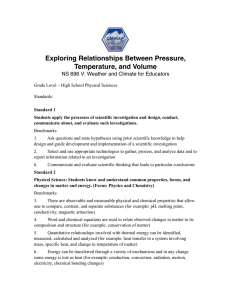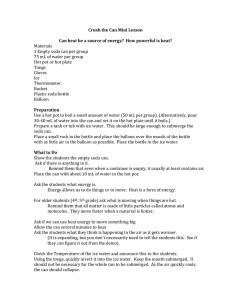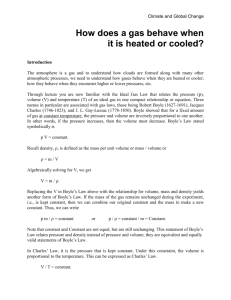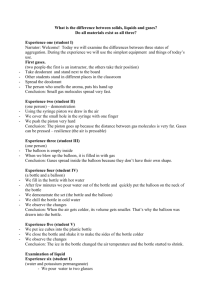How does a gas behave when it is heated or cooled?
advertisement
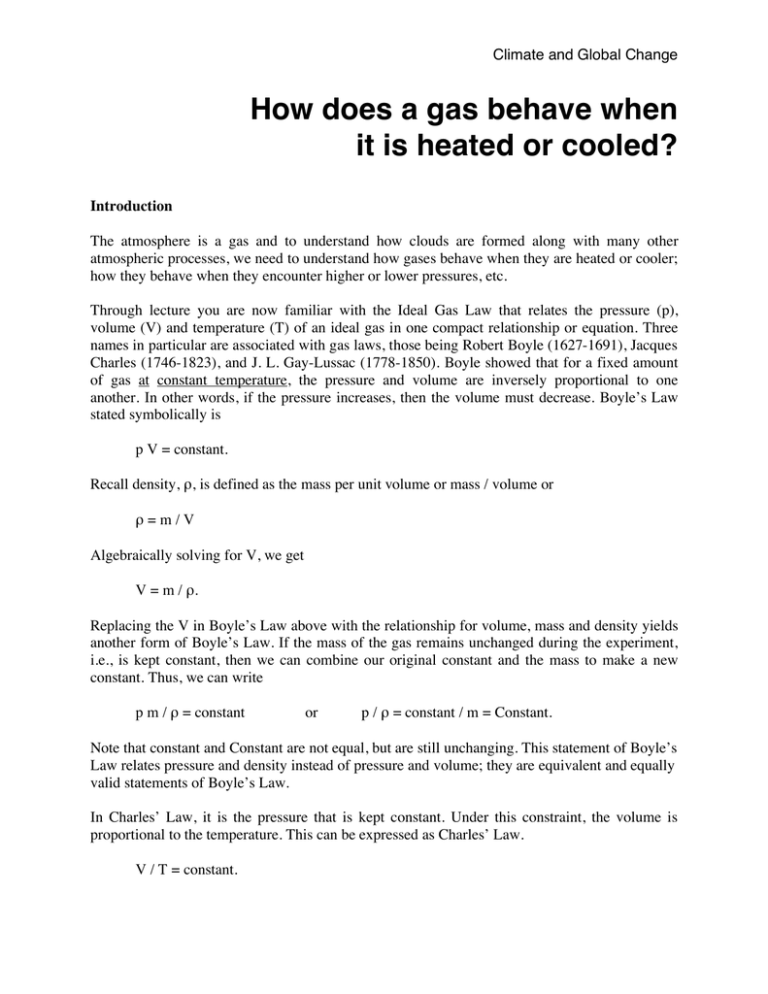
Climate and Global Change How does a gas behave when it is heated or cooled? Introduction The atmosphere is a gas and to understand how clouds are formed along with many other atmospheric processes, we need to understand how gases behave when they are heated or cooler; how they behave when they encounter higher or lower pressures, etc. Through lecture you are now familiar with the Ideal Gas Law that relates the pressure (p), volume (V) and temperature (T) of an ideal gas in one compact relationship or equation. Three names in particular are associated with gas laws, those being Robert Boyle (1627-1691), Jacques Charles (1746-1823), and J. L. Gay-Lussac (1778-1850). Boyle showed that for a fixed amount of gas at constant temperature, the pressure and volume are inversely proportional to one another. In other words, if the pressure increases, then the volume must decrease. Boyle’s Law stated symbolically is p V = constant. Recall density, ρ, is defined as the mass per unit volume or mass / volume or ρ=m/V Algebraically solving for V, we get V = m / ρ. Replacing the V in Boyle’s Law above with the relationship for volume, mass and density yields another form of Boyle’s Law. If the mass of the gas remains unchanged during the experiment, i.e., is kept constant, then we can combine our original constant and the mass to make a new constant. Thus, we can write p m / ρ = constant or p / ρ = constant / m = Constant. Note that constant and Constant are not equal, but are still unchanging. This statement of Boyle’s Law relates pressure and density instead of pressure and volume; they are equivalent and equally valid statements of Boyle’s Law. In Charles’ Law, it is the pressure that is kept constant. Under this constraint, the volume is proportional to the temperature. This can be expressed as Charles’ Law. V / T = constant. Climate and Global Change Or as above with Boyle’s Law, we can rewrite Charles’ Law to relate density and temperature as ρ T = constant. Recall that the temperature in Charles’ Law, and in Gay-Lussac’s Law, below must be the temperature expressed in Kelvin or Absolute degrees. Although not discussed in lecture, if the volume is kept constant, it is the pressure of the gas that is proportional to temperature, i.e., Gay-Lussac’s Law. P / T = constant. Note the constants in these equations are different constants. All of the above laws are combined in the Ideal Gas Law. An Ideal Gas What is an ideal gas? An ideal gas has a number of properties; real gases often exhibit behavior very close to ideal. The properties of an ideal gas are: • • • • An ideal gas consists of a large number of identical molecules. The volume occupied by the molecules themselves is negligible compared to the volume occupied by the gas, i.e., the space between molecules is large compared to the size of the molecules. The molecules obey Newton’s laws of motion, and they move in random motion. The molecules experience forces only during collisions; any collisions are completely elastic, and take a negligible amount of time. Thus, an ideal gas is an idealized model of real gases; real gases follow ideal gas behavior if their density is low enough that the gas molecules don’t interact much, and when they do interact their collisions can be approximated as elastic, i.e., with no loss of kinetic energy. The behavior of an ideal gas, that is, the relationship of pressure, volume and temperature, can be summarized by the Ideal Gas Law. p V / T = constant or p / ρ T = constant Note the constant depends on the gas. For dry air the constant is 287.06 Joules / kg - K. Part I: Temperature, Volume and Density Experiment This is a simple experiment that qualitatively demonstrates the effects of temperature on volume and density as predicted by the Ideal Gas Law. We will use a 3-liter bottle, a balloon, an ice bath and a hot water (heat the water to near boiling using a tea pot) bath. Climate and Global Change First, cool the bottle (without the balloon on top) and the air within the bottle by placing the bottle in the ice bath for a few minutes. After the elapsed time, place the balloon over the top of the bottle. This seals the air molecules within the bottle and inhibits the exchange of molecules between the air molecules within the bottle and the environmental air molecules. Next place the bottle, with the balloon on top, in the hot water bath. Note what happens to the balloon after a short period of time. Based on the Ideal Gas Law, explain your observations. What do you think the pressure is in the bottle; greater than, the same as, or less than the pressure outside the bottle? Explain why you believe your answer. What would have happened if we had performed this experiment with a stopper placed in the bottle instead of covered with the balloon? In this case what do you think the pressure would be in the bottle; greater than, the same as, or less than the pressure outside the bottle? Next remove the balloon and let environmental air into the bottle. Let the bottle set in the hot water bath for a few minutes so the air in the bottle will come to equilibrium with the warm water. Replace the balloon and again place the bottle in the ice bath. However, before doing this, explain what you expect to occur. Now place the bottle in the ice bath and compare your observations with your predictions. Climate and Global Change This experiment demonstrates how volume and therefore, density (since the number of molecules, i.e., the mass of the gas is not changed except when the balloon is removed) changes with changes in temperature. Recall the discussions in class regarding how side-by-side hot and cold air columns can induce horizontal pressure variations as one proceeds upward through the atmosphere. Recall that these pressure variations resulted from temperature induced density differences. Part II: Some Ideal Gas Law Calculations Recalling that pressure always decreases with height and using the Ideal Gas Law, calculate the pressure at which a balloon would burst if it can only expand to twice its original sea-level size. For this calculation, assume that the temperature is constant throughout the depth of the atmosphere. Please show your work. p = __________________ mb Calculate the temperature at which a balloon would burst if it can only expand to 1.2 times its original size. For this calculation, assume that the original temperature of the air in the balloon is 77°F and that the pressure is constant while you are warming the balloon. Please show your work. T = __________________ K Climate and Global Change Calculate the pressure in a bottle if the original pressure was 1000 mb and the absolute or Kelvin temperature of the air in the bottle were cooled to half its original value. Please show your work. p = __________________ mb Calculate the density of air in a balloon if the original density was 1.2 kg per m3 and the temperature of the air in the balloon were cooled from 37°C to 17°C. Please show your work. ρ = __________________ kg/m3
